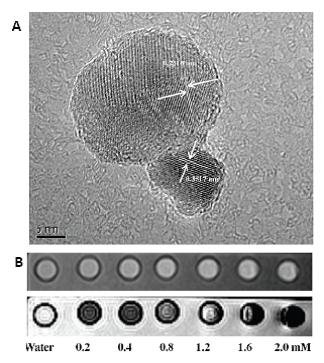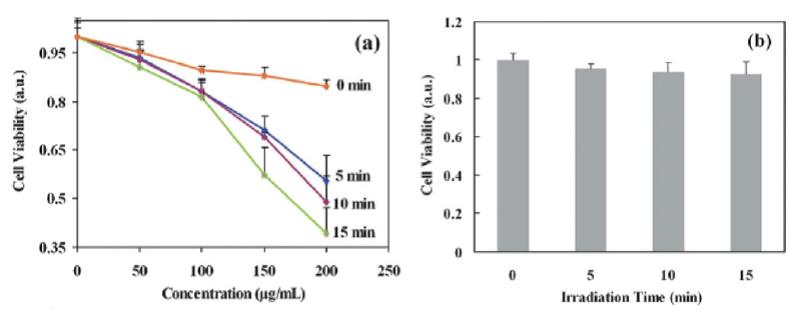It is well known that MRI is one of the most important imaging techniques in clinical medicine due to its low toxicity, good biocompatibility and high sensitivity. During the clinical MRI scanning, MRI contrast agents are used within 30-40 % of the cases. At present, MRI contrast agents in clinical use can be classified into Type T1, such as gadolinium (Gd) chelates with a high longitudinal relaxivity r1, and Type T2 like super-paramagnetic iron oxide nanoparticles (SPION) with a high transverse relaxivity r2. The commercial MRI contrast agents can only change tissue contrast, but do not have a therapeutic function.
The research group led by Prof. Aiguo Wu from the Ningbo Institute of Materials Technology & Engineering (NIMTE), CAS, has explored the water-phase synthesis of multifunctional Fe3O4-TiO2 nanocomposites with Janus structure. The size of the Janus Fe3O4-TiO2 nanocomposites is 30-40 nm, the r2 value is around 54.691 mM-1S-1 and the r2/r1 value is larger than 3.
 |
|
Fig.1 A: HRTEM image of Fe3O4-TiO2 nanocomposites; B: T1- and T2-weighted MR images of Fe3O4-TiO2 nanocomposites. |
The HRTEM image of Fe3O4-TiO2 nanocomposites (Fig.1) shows that Fe3O4 is coupled with TiO2 nanoparticles to form a Janus structure. The interplanar distance of two parts is 0.2518 nm and 0.3517 nm respectively, which corresponds well with the (311) plane of Fe3O4 and the (101) plane of TiO2. The results of MR images indicate that the as-prepared Fe3O4-TiO2 nanocomposites have good T2-weighted MRI performance.
 |
|
Fig.2 Cell viability before and after UV light irradiation (a) MCF-7 cells incubated with Fe3O4-TiO2 nanocomposites (b) MCF-7 cells without Fe3O4-TiO2 nanocomposites. |
The results (Fig.2) indicate that Fe3O4-TiO2 nanocomposites are critical for determination of cell viability under UV light irradiation. Moreover, the suitable concentration of Fe3O4-TiO2 nanocomposites and the proper duration time of UV irradiation are very important for the PDT performance.
Therefore, the Fe3O4-TiO2 nanocomposites could be good inorganic photosensitizers. They may have potential applications as multifunctional agents of MRI and PDT for the diagnosis and treatment of cancers in the future.
The work has been published on Nanoscale (2013, 5, 2107-2113) and a related patent has been authorized (No.201010039632.0).
Professor Aiguo Wu Aiguo@nimte.ac.cn
Research Group Url: http://english.nimte.cas.cn/rh/rd/nb
All Images by ![]()

